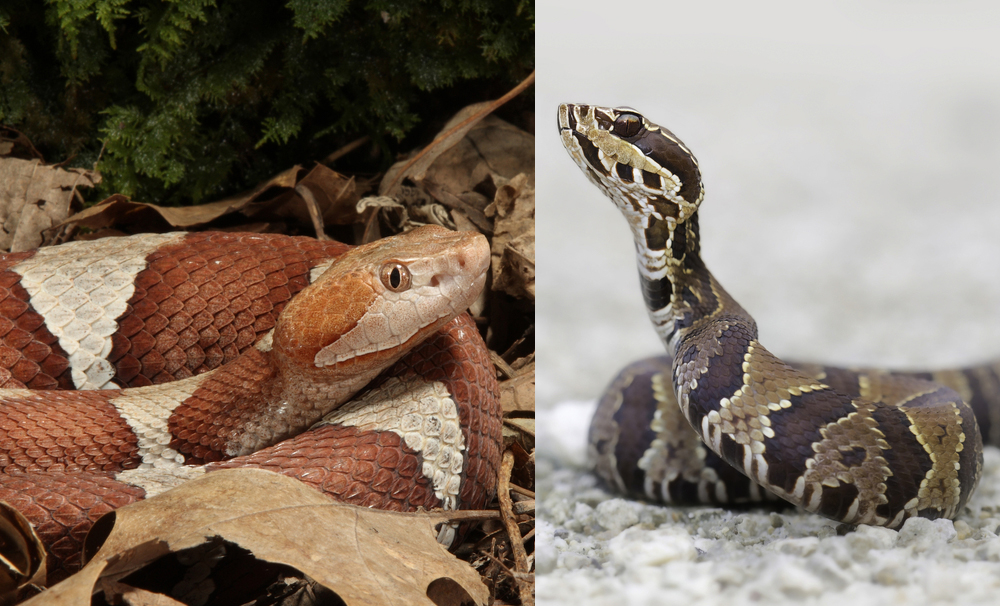Viper vs. Viper! Never-Before-Seen Combat Recorded

Male snakes in the viper family — a venomous group of snakes that have hinged fangs — are known for engaging in fierce wrestling matches when they compete for females. But combat between two different viper species has never been observed — until now.
On Sept. 6, Dawn Kelly was astounded to come across an unexpected and intense battle between a cottonmouth and a copperhead near her cabin in Snowball, Arkansas, close to the Buffalo National River Park in the northern part of the state.
Kelly captured video footage of the unusual encounter on her smartphone, and shared it with biologist David Steen, an assistant research professor at Auburn University Museum of Natural History in Alabama. Steen is an active science communicator on Twitter (@AlongsideWild) and on his blog, Living Alongside Wildlife. He is particularly well-known for answering questions from the public about snakes. [101 Animal Photographs You'll Go Wild Over]
In the video, two sizable males square off in a rural area next to pieces of discarded tin, wrapping their bodies around each other in a test of strength so intense that Kelly was able to film for several minutes without disturbing the serpents, she said.
Kelly told Live Science that she was in her cabin when she looked out the window and noticed that her neighbor's dog was motioning toward two snakes in the weeds. She went outside to take a closer look, and that's when she saw that not only were the snakes battling each other, but also that they were two different viper species.
Having grown up on a farm, Kelly said she was no stranger to Arkansas wildlife. She once nursed an injured king snake back to health, and described herself as "the girl who flips over every piece of plywood to see who's under it." Kelly said she was familiar with snakes in the area. Vipers like cottonmouths and copperheads are common, though they tend to be reclusive and are not seen as frequently as other types of snakes, she added. She said she recognized that what she was seeing was highly unusual, and so she started filming it with her phone.
Kelly described the vipers as "well over 2 feet [0.6 meters] long," and they were so preoccupied with each other that she was able to approach to within just a few feet of them.
Sign up for the Live Science daily newsletter now
Get the world’s most fascinating discoveries delivered straight to your inbox.
"They didn't even notice me until I yelled at the dog to get away," she said.
Steen said snakes are difficult to study in a controlled manner, so a lot about how they live and interact with each other remains a mystery.
"Something like this cool behavior — you just don't see it that often," he told Live Science. "To my knowledge, no one's ever documented two different vipers in combat before."
Steen explained that the two males were likely competing for a female that was hidden from view, adding that since the vipers are different species, they typically can't interbreed. When Steen posted the footage on YouTube, he said in the description that he and other researchers would be investigating this peculiar incident further.
"It's one observation, so we don't want to read into it too much. We don't know if it's necessarily widespread behavior," Steen told Live Science. "But it does make us want to rethink what we know about how these species interact with each other."
Original article on Live Science.

Mindy Weisberger is an editor at Scholastic and a former Live Science channel editor and senior writer. She has reported on general science, covering climate change, paleontology, biology and space. Mindy studied film at Columbia University; prior to Live Science she produced, wrote and directed media for the American Museum of Natural History in New York City. Her videos about dinosaurs, astrophysics, biodiversity and evolution appear in museums and science centers worldwide, earning awards such as the CINE Golden Eagle and the Communicator Award of Excellence. Her writing has also appeared in Scientific American, The Washington Post and How It Works Magazine. Her book "Rise of the Zombie Bugs: The Surprising Science of Parasitic Mind Control" will be published in spring 2025 by Johns Hopkins University Press.









